(完整word版)英语中19种修辞手法及解释
- 格式:doc
- 大小:46.02 KB
- 文档页数:7
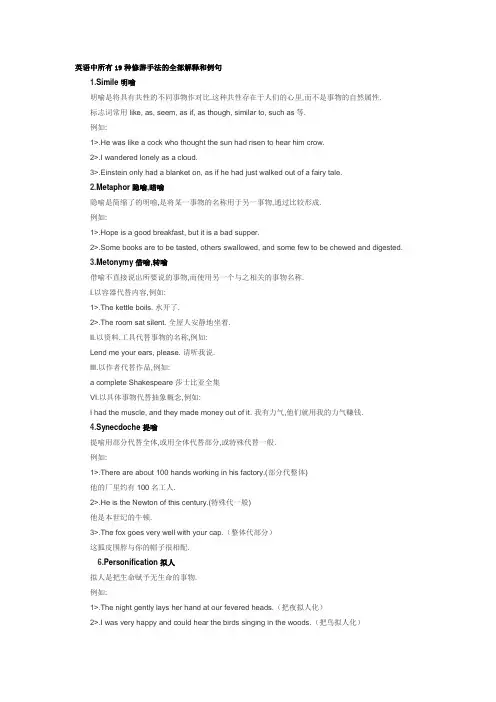
英语中所有19种修辞手法的全部解释和例句1.Simile 明喻明喻是将具有共性的不同事物作对比.这种共性存在于人们的心里,而不是事物的自然属性.标志词常用 like, as, seem, as if, as though, similar to, such as等.例如:1>.He was like a cock who thought the sun had risen to hear him crow.2>.I wandered lonely as a cloud.3>.Einstein only had a blanket on, as if he had just walked out of a fairy tale.2.Metaphor 隐喻,暗喻隐喻是简缩了的明喻,是将某一事物的名称用于另一事物,通过比较形成.例如:1>.Hope is a good breakfast, but it is a bad supper.2>.Some books are to be tasted, others swallowed, and some few to be chewed and digested.3.Metonymy 借喻,转喻借喻不直接说出所要说的事物,而使用另一个与之相关的事物名称.I.以容器代替内容,例如:1>.The kettle boils. 水开了.2>.The room sat silent. 全屋人安静地坐着.II.以资料.工具代替事物的名称,例如:Lend me your ears, please. 请听我说.III.以作者代替作品,例如:a complete Shakespeare 莎士比亚全集VI.以具体事物代替抽象概念,例如:I had the muscle, and they made money out of it. 我有力气,他们就用我的力气赚钱.4.Synecdoche 提喻提喻用部分代替全体,或用全体代替部分,或特殊代替一般.例如:1>.There are about 100 hands working in his factory.(部分代整体)他的厂里约有100名工人.2>.He is the Newton of this century.(特殊代一般)他是本世纪的牛顿.3>.The fox goes very well with your cap.(整体代部分)这狐皮围脖与你的帽子很相配.6.Personification 拟人拟人是把生命赋予无生命的事物.例如:1>.The night gently lays her hand at our fevered heads.(把夜拟人化)2>.I was very happy and could hear the birds singing in the woods.(把鸟拟人化)7.Hyperbole 夸张夸张是以言过其实的说法表达强调的目的.它可以加强语势,增加表达效果..例如:1>.I beg a thousand pardons.2>.Love you. You are the whole world to me, and the moon and the stars.3>.When she heard the bad news, a river of tears poured out.9.Euphemism 委婉,婉辞法婉辞法指用委婉,文雅的方法表达粗恶,避讳的话.例如:1>.He is out visiting the necessary. 他出去方便一下.2>.His relation with his wife has not been fortunate. 他与妻子关系不融洽.3>.Deng Xiaoping passed away in 1997. (去世)11.Irony 反语反语指用相反意义的词来表达意思的作文方式.如在指责过失.错误时,用赞同过失的说法,而在表扬时,则近乎责难的说法.例如:1>.It would be a fine thing indeed not knowing what time it was in the morning.早上没有时间观念还真是一件好事啊(真实含义是应该明确早上的时间观念)2>"Of course, you only carry large notes, no small change on you. "the waiter said to the beggar.12.Pun 双关双关就是用一个词在句子中的双重含义,借题发挥.作出多种解释,旁敲侧击,从而达到意想不到的幽默.滑稽效果.它主要以相似的词形.词意和谐音的方式出现.例如:1>.She is too low for a high praise, too brown for a fair praise and too little for a great praise.2>.An ambassador is an honest man who lies abroad for the good of his country.3>.If we don't hang together, we shall hang separately.13.Parody 仿拟这是一种模仿名言.警句.谚语,改动其中部分词语,从而使其产生新意的修辞.例如:1>.Rome was not built in a day, nor in a year.2>.A friend in need is a friend to be avoided.3>.If you give a girl an inch nowadays she will make address of it.15.Antithesis 对照,对比,对偶这种修辞指将意义完全相反的语句排在一起对比的一种修辞方法.例如:1>.Not that I loved Caeser less but that I loved Romemore.2>.You are staying; I am going.3>.Give me liberty, or give me death.17.Oxymoron 反意法,逆喻这也是一种矛盾修辞法,用两种不相调和的特征形容一个事物,以不协调的搭配使读者领悟句中微妙的含义.例如:1>.No light, but rather darkness visible.没有光亮,黑暗却清晰可见2>.The state of this house is cheerless welcome.Transferred Epithet: (移就) It is a figure of speech where an epithet (an adjective ordescriptive phrase) is transferred from the noun it should rightly modify(修饰) to another to which itdoes not really apply or belong. For instance, I spent sleepless nights on my project.1. Rushing thongs, blinded by the darkness and smoke, rushed up on a street and down the next trampling the fallen in a crazy fruitless dash toward safety.(Robert Silverbury: Pompeii)在黑暗和浓烟中狂奔的人群,沿着大街小巷踏着倒下的躯体,慌乱而徒劳地向安全地方冲闯。
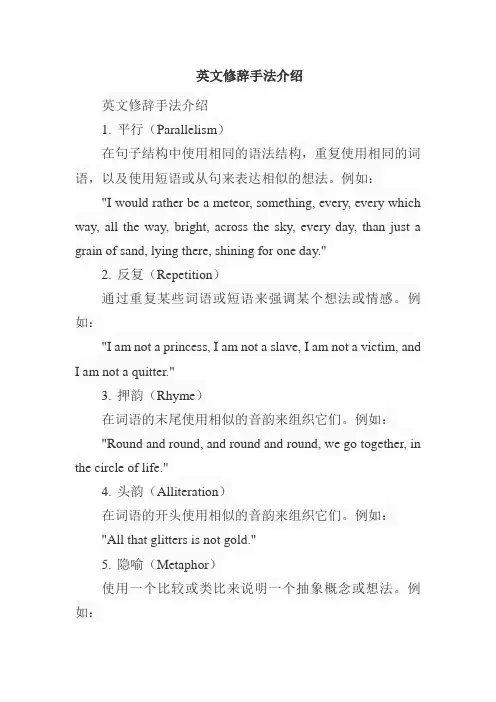
英文修辞手法介绍英文修辞手法介绍1. 平行(Parallelism)在句子结构中使用相同的语法结构,重复使用相同的词语,以及使用短语或从句来表达相似的想法。
例如:"I would rather be a meteor, something, every, every which way, all the way, bright, across the sky, every day, than just a grain of sand, lying there, shining for one day."2. 反复(Repetition)通过重复某些词语或短语来强调某个想法或情感。
例如:"I am not a princess, I am not a slave, I am not a victim, andI am not a quitter."3. 押韵(Rhyme)在词语的末尾使用相似的音韵来组织它们。
例如:"Round and round, and round and round, we go together, in the circle of life."4. 头韵(Alliteration)在词语的开头使用相似的音韵来组织它们。
例如:"All that glitters is not gold."5. 隐喻(Metaphor)使用一个比较或类比来说明一个抽象概念或想法。
例如:"He is a lion in battle."6. 明喻(Simile)使用像“像”或“如同”这样的词语来比较两个不同的事物或概念。
例如:"She sings like a bird."7. 反问(Rhetorical question)使用一个问题来表达一个陈述或观点,而不是提出真正的问题。
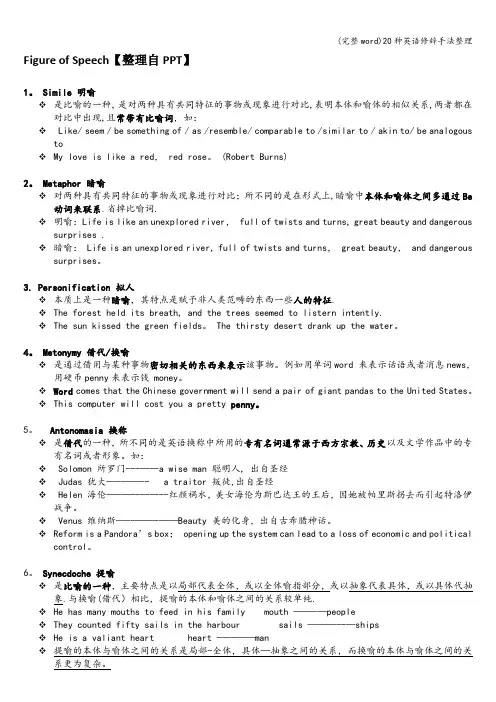
Figure of Speech【整理自PPT】1。
Simile 明喻❖是比喻的一种,是对两种具有共同特征的事物或现象进行对比,表明本体和喻体的相似关系,两者都在对比中出现,且常带有比喻词,如:❖ Like/ seem / be something of / as /resemble/ comparable to /similar to / akin to/ be analogous to❖My love is like a red, red rose。
(Robert Burns)2。
Metaphor 暗喻❖对两种具有共同特征的事物或现象进行对比;所不同的是在形式上,暗喻中本体和喻体之间多通过Be 动词来联系.省掉比喻词.❖明喻:Life is like an unexplored river, full of twists and turns, great beauty and dangerous surprises .❖暗喻: Life is an unexplored river, full of twists and turns, great beauty, and dangerous surprises。
3. Personification 拟人❖本质上是一种暗喻,其特点是赋予非人类范畴的东西一些人的特征.❖The forest held its breath, and the trees seemed to listern intently.❖The sun kissed the green fields。
The thirsty desert drank up the water。
4。
Metonymy 借代/换喻❖是通过借用与某种事物密切相关的东西来表示该事物。
例如用单词word 来表示话语或者消息news,用硬币penny来表示钱 money。
❖Word comes that the Chinese government will send a pair of giant pandas to the United States。
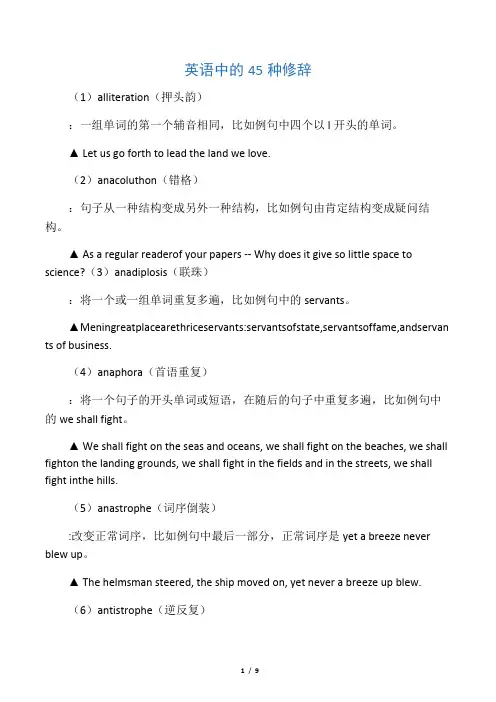
英语中的45种修辞(1)alliteration(押头韵):一组单词的第一个辅音相同,比如例句中四个以l开头的单词。
▲ Let us go forth to lead the land we love.(2)anacoluthon(错格):句子从一种结构变成另外一种结构,比如例句由肯定结构变成疑问结构。
▲ As a regular readerof your papers -- Why does it give so little space to science?(3)anadiplosis(联珠):将一个或一组单词重复多遍,比如例句中的servants。
▲Meningreatplacearethriceservants:servantsofstate,servantsoffame,andservan ts of business.(4)anaphora(首语重复):将一个句子的开头单词或短语,在随后的句子中重复多遍,比如例句中的we shall fight。
▲ We shall fight on the seas and oceans, we shall fight on the beaches, we shall fighton the landing grounds, we shall fight in the fields and in the streets, we shall fight inthe hills.(5)anastrophe(词序倒装):改变正常词序,比如例句中最后一部分,正常词序是yet a breeze never blew up。
▲ The helmsman steered, the ship moved on, yet never a breeze up blew.(6)antistrophe(逆反复):在每个句子的结尾,重复相同的单词或短语,比如例句中的without warning。
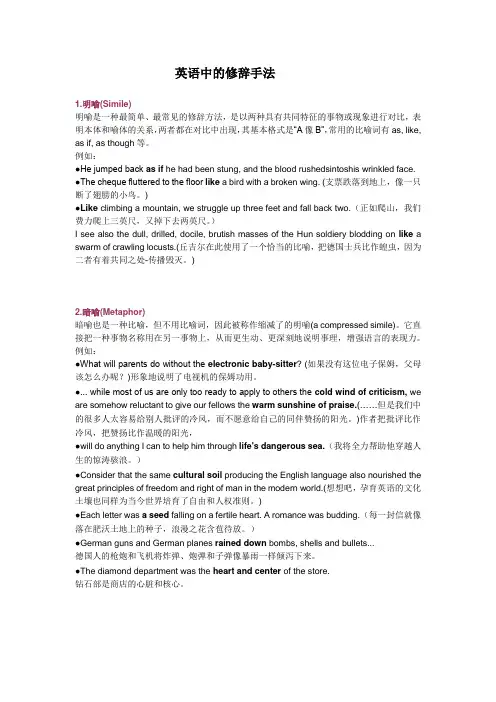
英语中的修辞手法1.明喻(Simile)明喻是一种最简单、最常见的修辞方法,是以两种具有共同特征的事物或现象进行对比,表明本体和喻体的关系,两者都在对比中出现,其基本格式是“A像B”,常用的比喻词有as, like, as if, as though等。
例如:●He jumped back as if he had been stung, and the blood rushedsintoshis wrinkled face.●The cheque fluttered to the floor like a bird with a broken wing. (支票跌落到地上,像一只断了翅膀的小鸟。
)●Like climbing a mountain, we struggle up three feet and fall back two.(正如爬山,我们费力爬上三英尺,又掉下去两英尺。
)I see also the dull, drilled, docile, brutish masses of the Hun soldiery blodding on like a swarm of crawling locusts.(丘吉尔在此使用了一个恰当的比喻,把德国士兵比作蝗虫,因为二者有着共同之处-传播毁灭。
)2.暗喻(Metaphor)暗喻也是一种比喻,但不用比喻词,因此被称作缩减了的明喻(a compressed simile)。
它直接把一种事物名称用在另一事物上,从而更生动、更深刻地说明事理,增强语言的表现力。
例如:●What will parents do without the electronic baby-sitter? (如果没有这位电子保姆,父母该怎么办呢?)形象地说明了电视机的保姆功用。
●... while most of us are only too ready to apply to others the cold wind of criticism, we are somehow reluctant to give our fellows the warm sunshine of praise.(……但是我们中的很多人太容易给别人批评的冷风,而不愿意给自己的同伴赞扬的阳光。
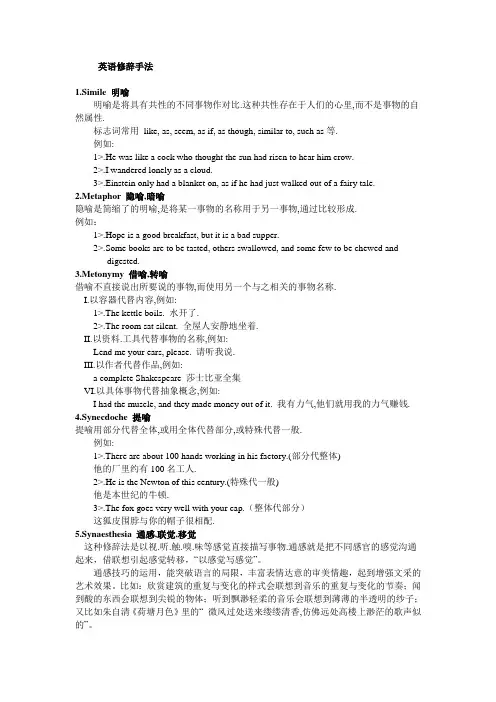
英语修辞手法1.Simile 明喻明喻是将具有共性的不同事物作对比.这种共性存在于人们的心里,而不是事物的自然属性.标志词常用like, as, seem, as if, as though, similar to, such as等.例如:1>.He was like a cock who thought the sun had risen to hear him crow.2>.I wandered lonely as a cloud.3>.Einstein only had a blanket on, as if he had just walked out of a fairy tale.2.Metaphor 隐喻,暗喻隐喻是简缩了的明喻,是将某一事物的名称用于另一事物,通过比较形成.例如:1>.Hope is a good breakfast, but it is a bad supper.2>.Some books are to be tasted, others swallowed, and some few to be chewed anddigested.3.Metonymy 借喻,转喻借喻不直接说出所要说的事物,而使用另一个与之相关的事物名称.I.以容器代替内容,例如:1>.The kettle boils. 水开了.2>.The room sat silent. 全屋人安静地坐着.II.以资料.工具代替事物的名称,例如:Lend me your ears, please. 请听我说.III.以作者代替作品,例如:a complete Shakespeare 莎士比亚全集VI.以具体事物代替抽象概念,例如:I had the muscle, and they made money out of it. 我有力气,他们就用我的力气赚钱.4.Synecdoche 提喻提喻用部分代替全体,或用全体代替部分,或特殊代替一般.例如:1>.There are about 100 hands working in his factory.(部分代整体)他的厂里约有100名工人.2>.He is the Newton of this century.(特殊代一般)他是本世纪的牛顿.3>.The fox goes very well with your cap.(整体代部分)这狐皮围脖与你的帽子很相配.5.Synaesthesia 通感,联觉,移觉这种修辞法是以视.听.触.嗅.味等感觉直接描写事物.通感就是把不同感官的感觉沟通起来,借联想引起感觉转移,“以感觉写感觉”。
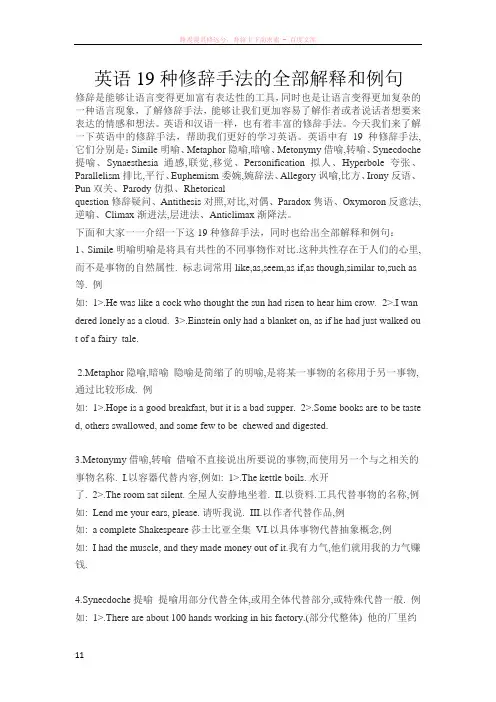
英语19种修辞手法的全部解释和例句修辞是能够让语言变得更加富有表达性的工具,同时也是让语言变得更加复杂的一种语言现象,了解修辞手法,能够让我们更加容易了解作者或者说话者想要来表达的情感和想法。
英语和汉语一样,也有着丰富的修辞手法。
今天我们来了解一下英语中的修辞手法,帮助我们更好的学习英语。
英语中有19种修辞手法,它们分别是:Simile明喻、Metaphor隐喻,暗喻、Metonymy借喻,转喻、Synecdoche 提喻、Synaesthesia通感,联觉,移觉、Personification拟人、Hyperbole夸张、Parallelism排比,平行、Euphemism委婉,婉辞法、Allegory讽喻,比方、Irony反语、Pun双关、Parody仿拟、Rhetoricalquestion修辞疑问、Antithesis对照,对比,对偶、Paradox隽语、Oxymoron反意法,逆喻、Climax渐进法,层进法、Anticlimax渐降法。
下面和大家一一介绍一下这19种修辞手法,同时也给出全部解释和例句:1、Simile明喻明喻是将具有共性的不同事物作对比.这种共性存在于人们的心里,而不是事物的自然属性. 标志词常用like,as,seem,as if,as though,similar to,such as 等. 例如: 1>.He was like a cock who thought the sun had risen to hear him crow. 2>.I wan dered lonely as a cloud. 3>.Einstein only had a blanket on, as if he had just walked ou t of a fairy tale.2.Metaphor隐喻,暗喻隐喻是简缩了的明喻,是将某一事物的名称用于另一事物,通过比较形成. 例如: 1>.Hope is a good breakfast, but it is a bad supper. 2>.Some books are to be taste d, others swallowed, and some few to be chewed and digested.3.Metonymy借喻,转喻借喻不直接说出所要说的事物,而使用另一个与之相关的事物名称. I.以容器代替内容,例如: 1>.The kettle boils. 水开了. 2>.The room sat silent. 全屋人安静地坐着. II.以资料.工具代替事物的名称,例如: Lend me your ears, please. 请听我说. III.以作者代替作品,例如: a complete Shakespeare 莎士比亚全集 VI.以具体事物代替抽象概念,例如: I had the muscle, and they made money out of it.我有力气,他们就用我的力气赚钱.4.Synecdoche提喻提喻用部分代替全体,或用全体代替部分,或特殊代替一般. 例如: 1>.There are about 100 hands working in his factory.(部分代整体) 他的厂里约有100名工人. 2>.He is the Newton of this century.(特殊代一般) 他是本世纪的牛顿. 3>.The fox goes very well with your cap.(整体代部分) 这狐皮围脖与你的帽子很相配.5.Synaesthesia通感,联觉,移觉这种修辞法是以视.听.触.嗅.味等感觉直接描写事物.通感就是把不同感官的感觉沟通起来,借联想引起感觉转移,“以感觉写感觉”。
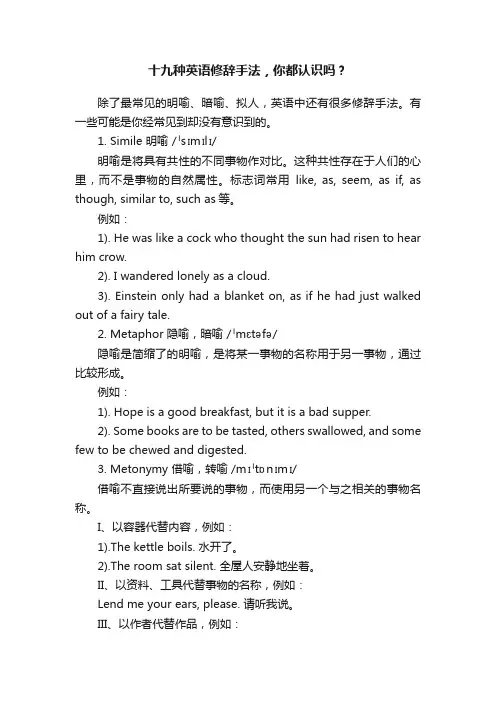
十九种英语修辞手法,你都认识吗?除了最常见的明喻、暗喻、拟人,英语中还有很多修辞手法。
有一些可能是你经常见到却没有意识到的。
1. Simile 明喻 /ˈsɪmɪlɪ/明喻是将具有共性的不同事物作对比。
这种共性存在于人们的心里,而不是事物的自然属性。
标志词常用like, as, seem, as if, as though, similar to, such as等。
例如:1). He was like a cock who thought the sun had risen to hear him crow.2). I wandered lonely as a cloud.3). Einstein only had a blanket on, as if he had just walked out of a fairy tale.2. Metaphor 隐喻,暗喻 /ˈmɛtəfə/隐喻是简缩了的明喻,是将某一事物的名称用于另一事物,通过比较形成。
例如:1). Hope is a good breakfast, but it is a bad supper.2). Some books are to be tasted, others swallowed, and some few to be chewed and digested.3. Metonymy 借喻,转喻 /mɪˈtɒnɪmɪ/借喻不直接说出所要说的事物,而使用另一个与之相关的事物名称。
I、以容器代替内容,例如:1).The kettle boils. 水开了。
2).The room sat silent. 全屋人安静地坐着。
II、以资料、工具代替事物的名称,例如:Lend me your ears, please. 请听我说。
III、以作者代替作品,例如:a complete Shakespeare 莎士比亚全集IV、以具体事物代替抽象概念,例如:I had the muscle, and they made money out of it.我有力气,他们就用我的力气赚钱。
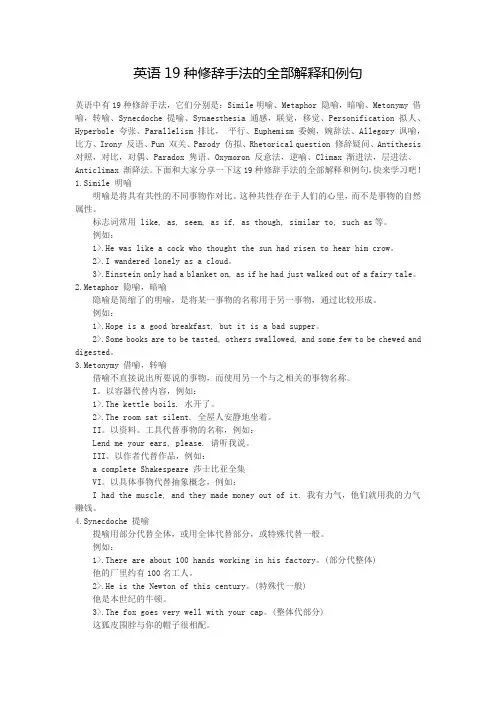
英语19种修辞手法的全部解释和例句英语中有19种修辞手法,它们分别是:Simile明喻、Metaphor 隐喻,暗喻、Metonymy 借喻,转喻、Synecdoche 提喻、Synaesthesia 通感,联觉,移觉、Personification 拟人、Hyperbole 夸张、Parallelism 排比,平行、Euphemism 委婉,婉辞法、Allegory 讽喻,比方、Irony 反语、Pun 双关、Parody 仿拟、Rhetorical question 修辞疑问、Antithesis 对照,对比,对偶、Paradox 隽语、Oxymoron 反意法,逆喻、Climax 渐进法,层进法、Anticlimax 渐降法。
下面和大家分享一下这19种修辞手法的全部解释和例句,快来学习吧!1.Simile 明喻明喻是将具有共性的不同事物作对比。
这种共性存在于人们的心里,而不是事物的自然属性。
标志词常用 like, as, seem, as if, as though, similar to, such as等。
例如:1>.He was like a cock who thought the sun had risen to hear him crow。
2>.I wandered lonely as a cloud。
3>.Einstein only had a blanket on, as if he had just walked out of a fairy tale。
2.Metaphor 隐喻,暗喻隐喻是简缩了的明喻,是将某一事物的名称用于另一事物,通过比较形成。
例如:1>.Hope is a good breakfast, but it is a bad supper。
2>.Some books are to be tasted, others swallowed, and some few to be chewed and digested。
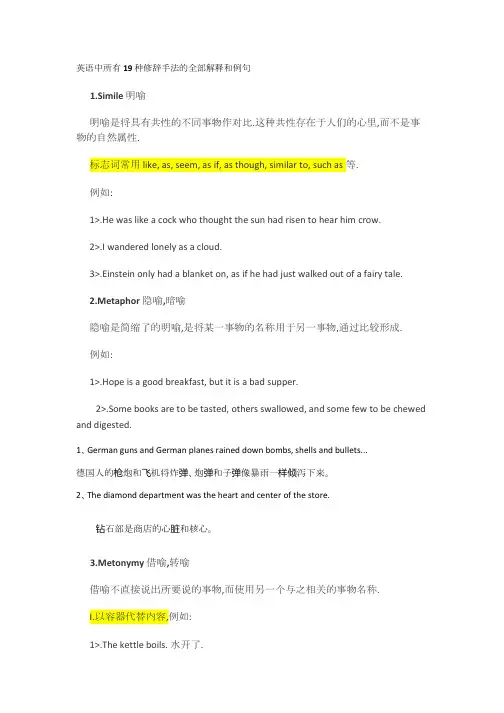
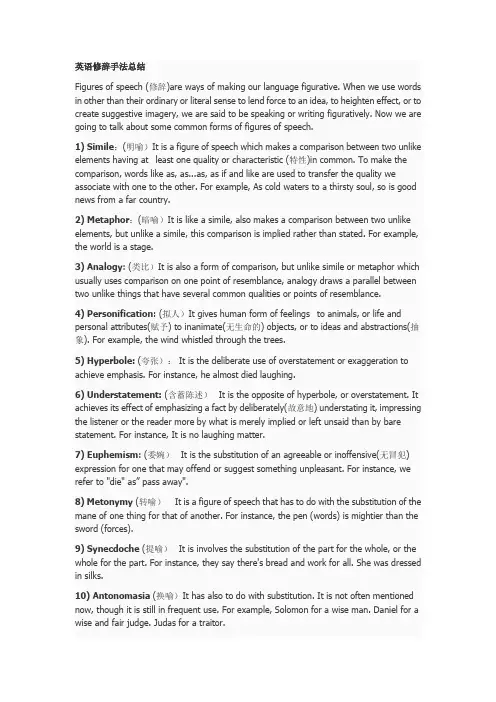
英语修辞手法总结Figures of speech (修辞)are ways of making our language figurative. When we use words in other than their ordinary or literal sense to lend force to an idea, to heighten effect, or to create suggestive imagery, we are said to be speaking or writing figuratively. Now we are going to talk about some common forms of figures of speech.1) Simile:(明喻)It is a figure of speech which makes a comparison between two unlike elements having at least one quality or characteristic (特性)in common. To make the comparison, words like as, as...as, as if and like are used to transfer the quality we associate with one to the other. For example, As cold waters to a thirsty soul, so is good news from a far country.2) Metaphor:(暗喻)It is like a simile, also makes a comparison between two unlike elements, but unlike a simile, this comparison is implied rather than stated. For example, the world is a stage.3) Analogy: (类比)It is also a form of comparison, but unlike simile or metaphor which usually uses comparison on one point of resemblance, analogy draws a parallel between two unlike things that have several common qualities or points of resemblance.4) Personification: (拟人)It gives human form of feelings to animals, or life and personal attributes(赋予) to inanimate(无生命的) objects, or to ideas and abstractions(抽象). For example, the wind whistled through the trees.5) Hyperbole: (夸张): It is the deliberate use of overstatement or exaggeration to achieve emphasis. For instance, he almost died laughing.6) Understatement: (含蓄陈述)It is the opposite of hyperbole, or overstatement. It achieves its effect of emphasizing a fact by deliberately(故意地) understating it, impressing the listener or the reader more by what is merely implied or left unsaid than by bare statement. For instance, It is no laughing matter.7) Euphemism: (委婉)It is the substitution of an agreeable or inoffensive(无冒犯) expression for one that may offend or suggest something unpleasant. For instance, we refer to "die" as” pass away".8) Metonymy (转喻)It is a figure of speech that has to do with the substitution of the mane of one thing for that of another. For instance, the pen (words) is mightier than the sword (forces).9) Synecdoche (提喻)It is involves the substitution of the part for the whole, or the whole for the part. For instance, they say there's bread and work for all. She was dressed in silks.10) Antonomasia (换喻)It has also to do with substitution. It is not often mentioned now, though it is still in frequent use. For example, Solomon for a wise man. Daniel for a wise and fair judge. Judas for a traitor.11) Pun: (双关语)It is a play on words, or rather a play on the form and meaning of words. For instance, a cannon-ball took off his legs, so he laid down his arms. (Here "arms" has two meanings: a person's body; weapons carried by a soldier.)12) Solipsism: (一语双叙)It has two connotations. In the first case, it is a figure by which a word, or a particular form or inflection of a word, refers to two or more words in the same sentence, while properly applying to or agreeing with only on of them in grammar or syntax(句法). For example, He addressed you and me, and desired us to follow him. (Here we are used to refer to you and me.)In the second case, it a word may refer to two or more words in the same sentence. For example, while he was fighting, and losing limb and mind, and dying, others stayed behind to pursue education and career. (Here to losing one's limbs in literal; to lose one's mind is figurative, and means to go mad.)13) Zeugma: (轭式搭配)It is a single word which is made to modify or to govern two or more words in the same sentence, wither properly applying in sense to only one of them, or applying to them in different senses. For example, the sun shall not burn you by day or the moon by night. (Here noon is not strong enough to burn)14) Irony: (反语)It is a figure of speech that achieves emphasis by saying the opposite of what is meant, the intended meaning of the words being the opposite of their usual sense. For instance, we are lucky, what you said makes me feel real good. 15) Innuendo: (暗讽)It is a mild form of irony, hinting in a rather roundabout (曲折)way at something disparaging(不一致) or uncomplimentary(不赞美) to the person or subject mentioned. For example, the weatherman said it would be worm. He must take his readings in a bathroom.16) Sarcasm: (讽刺)It Sarcasm is a strong form of irony. It attacks in a taunting and bitter manner, and its aim is to disparage, ridicule and wound the feelings of the subject attacked. For example, laws are like cobwebs, which may catch small flies, but let wasps break through.17) Paradox: (似非而是的隽语)It is a figure of speech consisting of a statement or proposition which on the face of it seems self-contradictory, absurd or contrary toestablished fact or practice, but which onfurther thinking and study may prove to be true, well-founded, and even to contain a succinct point. For example more haste, less speed.18) Oxymoron: (矛盾修饰)It is a compressed paradox, formed by the conjoining(结合) of two contrasting, contradictory or incongruous(不协调) terms as in bitter-sweet memories, orderly chaos(混乱) and proud humility(侮辱).19) Antithesis: (对照)It is the deliberate arrangement of contrasting words or ideas in balanced structural forms to achieve emphasis. For example, speech is silver; silence is golden.20) Epigram: (警句)It states a simple truth pithily(有利地) and pungently(强烈地). It is usually terse and arouses interest and surprise by its deep insight into certain aspects of human behavior or feeling. For instance, Few, save the poor, feel for the poor.21) Climax: (渐进)It is derived from the Greek word for "ladder" and implies the progression of thought at a uniform or almost uniform rate of significance or intensity, like the steps of a ladder ascending evenly. For example, I came, I saw, I conquered.22) Anti-climax or bathos: (突降) It is the opposite of Climax. It involves stating one's thoughts in a descending order of significance or intensity, from strong to weak, from weighty to light or frivolous. For instance, But thousands die, without or this or that, die, and endow(赋予) a college, or a cat.23) Apostrophe:(顿呼)In this figure of speech, a thing, place, idea or person (dead or absent) is addressed as if present, listening and understanding what is being said.For instance, England! awake! awake! awake!24) Transferred Epithet: (转类形容词)It is a figure of speech where an epithet (an adjective or descriptive phrase) is transferred from the noun it should rightly modify(修饰) to another to which it does not really apply or belong. For instance, I spent sleepless nights on my project.25) Alliteration: (头韵)It has to do with the sound rather than the sense of words for effect. It is a device that repeats the same sound at frequent intervals(间隔) and since the sound repeated is usually the initial consonant sound, it is also called "front rhyme". For instance, the fair breeze blew, the white foam flew, the furrow followed free.26) Onomatopoeia: (拟声)It is a device that uses words which imitate the sounds made by an object (animate or inanimate), or which are associated with or suggestive(提示的) of some action or movement。
英语19种修辞手法的全部解释和例句修辞是能够让语言变得更加富有表达性的工具,同时也是让语言变得更加复杂的一种语言现象,了解修辞手法,能够让我们更加容易了解作者或者说话者想要来表达的情感和想法。
英语和汉语一样,也有着丰富的修辞手法。
今天我们来了解一下英语中的修辞手法,帮助我们更好的学习英语。
英语中有19种修辞手法,它们分别是:Simile明喻、Metaphor隐喻,暗喻、Metonymy借喻,转喻、Synecdoche 提喻、Synaesthesia通感,联觉,移觉、Personification拟人、Hyperbole夸张、Parallelism排比,平行、Euphemism委婉,婉辞法、Allegory讽喻,比方、Irony反语、Pun双关、Parody仿拟、Rhetoricalquestion修辞疑问、Antithesis对照,对比,对偶、Paradox隽语、Oxymoron反意法,逆喻、Climax渐进法,层进法、Anticlimax渐降法。
下面和大家一一介绍一下这19种修辞手法,同时也给出全部解释和例句:1、Simile明喻明喻是将具有共性的不同事物作对比.这种共性存在于人们的心里,而不是事物的自然属性. 标志词常用like,as,seem,as if,as though,similar to,such as 等. 例如: 1>.He was like a cock who thought the sun had risen to hear him crow. 2>.I wan dered lonely as a cloud. 3>.Einstein only had a blanket on, as if he had just walked ou t of a fairy tale.2.Metaphor隐喻,暗喻隐喻是简缩了的明喻,是将某一事物的名称用于另一事物,通过比较形成. 例如: 1>.Hope is a good breakfast, but it is a bad supper. 2>.Some books are to be taste d, others swallowed, and some few to be chewed and digested.3.Metonymy借喻,转喻借喻不直接说出所要说的事物,而使用另一个与之相关的事物名称. I.以容器代替内容,例如: 1>.The kettle boils. 水开了. 2>.The room sat silent. 全屋人安静地坐着. II.以资料.工具代替事物的名称,例如: Lend me your ears, please. 请听我说. III.以作者代替作品,例如: a complete Shakespeare 莎士比亚全集 VI.以具体事物代替抽象概念,例如: I had the muscle, and they made money out of it.我有力气,他们就用我的力气赚钱.4.Synecdoche提喻提喻用部分代替全体,或用全体代替部分,或特殊代替一般. 例如: 1>.There are about 100 hands working in his factory.(部分代整体) 他的厂里约有100名工人. 2>.He is the Newton of this century.(特殊代一般) 他是本世纪的牛顿. 3>.The fox goes very well with your cap.(整体代部分) 这狐皮围脖与你的帽子很相配.5.Synaesthesia通感,联觉,移觉这种修辞法是以视.听.触.嗅.味等感觉直接描写事物.通感就是把不同感官的感觉沟通起来,借联想引起感觉转移,“以感觉写感觉”。
英语中所有19种修辞手法的全部解释和例句拟声onomatopoeia,头韵alliteration,半韵assonance,移就transferred epithet,圆周句periodic sentences,反复repetition,倒装inversion,延喻 extended metaphor,共轭zeugma,嘲讽 ridicule 典故allusion1.Simile 明喻明喻是将具有共性的不同事物作对比.这种共性存在于人们的心里,而不是事物的自然属性.标志词常用 like, as, seem, as if, as though, similar to, such as等.例如:1>.He was like a cock who thought the sun had risen to hear him crow.2>.I wandered lonely as a cloud.3>.Einstein only had a blanket on, as if he had just walked out of a fairy tale.2.Metaphor 隐喻,暗喻隐喻是简缩了的明喻,是将某一事物的名称用于另一事物,通过比较形成.例如:1>.Hope is a good breakfast, but it is a bad supper.2>.Some books are to be tasted, others swallowed, and some few to be chewed and digested.3.Metonymy 借喻,转喻[mɪ'tɒnɪmɪ]借喻不直接说出所要说的事物,而使用另一个与之相关的事物名称.I.以容器代替内容,例如:1>.The kettle boils. 水开了.2>.The room sat silent. 全屋人安静地坐着.II.以资料.工具代替事物的名称,例如:Lend me your ears, please. 请听我说.III.以作者代替作品,例如:a complete Shakespeare 莎士比亚全集VI.以具体事物代替抽象概念,例如:I had the muscle, and they made money out of it. 我有力气,他们就用我的力气赚钱.4.Synecdoche 提喻[sɪ'nekdəkɪ]提喻用部分代替全体,或用全体代替部分,或特殊代替一般.例如:1>.There are about 100 hands working in his factory.(部分代整体)他的厂里约有100名工人.2>.He is the Newton of this century.(特殊代一般)他是本世纪的牛顿.3>.The fox goes very well with your cap.(整体代部分)这狐皮围脖与你的帽子很相配.5.Synaesthesia 通感,联觉,移觉[,sɪnɪs'θiːzɪə]这种修辞法是以视.听.触.嗅.味等感觉直接描写事物.通感就是把不同感官的感觉沟通起来,借联想引起感觉转移,“以感觉写感觉”。
英语修辞手法一、明喻(simile)是以两种具有相同特征的事物和现象进行对比,表明本体和喻体之间的相似关系,两者都在对比中出现。
常用比喻词like, as, as if, as though等,例如:1、This elephant is like a snake as anybody can see.这头象和任何人见到的一样像一条蛇。
2、He looked as if he had just stepped out of my book of fairytales and had passed me like a spirit.他看上去好像刚从我的童话故事书中走出来,像幽灵一样从我身旁走过去。
3、It has long leaves that sway in the wind like slim fingers reaching to touch something.它那长长的叶子在风中摆动,好像伸出纤细的手指去触摸什么东西似的。
二、隐喻(metaphor)这种比喻不通过比喻词进行,而是直接将用事物当作乙事物来描写,甲乙两事物之间的联系和相似之处是暗含的。
1、German guns and German planes rained down bombs, shells and bullets...德国人的枪炮和飞机将炸弹、炮弹和子弹像暴雨一样倾泻下来。
2、The diamond department was the heart and center of the store.钻石部是商店的心脏和核心。
三、提喻(synecdoche)又称举隅法,主要特点是局部代表全体,或以全体喻指部分,或以抽象代具体,或以具体代抽象。
例如:1、The Great Wall was made not only of stones and earth, but of the flesh and blood of millions of men.长城不仅是用石头和土建造的,而且是用几百万人的血和肉建成的。
英语中所有19种修辞手法的全部解释和例句拟声onomatopoeia,头韵alliteration,半韵assonance,移就transferred epithet,圆周句periodic sentences,反复repetition,倒装inversion,延喻 extended metaphor,共轭zeugma,嘲讽 ridicule 典故allusion1.Simile 明喻明喻是将具有共性的不同事物作对比.这种共性存在于人们的心里,而不是事物的自然属性.标志词常用 like, as, seem, as if, as though, similar to, such as等.例如:1>.He was like a cock who thought the sun had risen to hear him crow.2>.I wandered lonely as a cloud.3>.Einstein only had a blanket on, as if he had just walked out of a fairy tale.2.Metaphor 隐喻,暗喻隐喻是简缩了的明喻,是将某一事物的名称用于另一事物,通过比较形成.例如:1>.Hope is a good breakfast, but it is a bad supper.2>.Some books are to be tasted, others swallowed, and some few to be chewed and digested.3.Metonymy 借喻,转喻[mɪ'tɒnɪmɪ]借喻不直接说出所要说的事物,而使用另一个与之相关的事物名称.I.以容器代替内容,例如:1>.The kettle boils. 水开了.2>.The room sat silent. 全屋人安静地坐着.II.以资料.工具代替事物的名称,例如:Lend me your ears, please. 请听我说.III.以作者代替作品,例如:a complete Shakespeare 莎士比亚全集VI.以具体事物代替抽象概念,例如:I had the muscle, and they made money out of it. 我有力气,他们就用我的力气赚钱.4.Synecdoche 提喻[sɪ'nekdəkɪ]提喻用部分代替全体,或用全体代替部分,或特殊代替一般.例如:1>.There are about 100 hands working in his factory.(部分代整体)他的厂里约有100名工人.2>.He is the Newton of this century.(特殊代一般)他是本世纪的牛顿.3>.The fox goes very well with your cap.(整体代部分)这狐皮围脖与你的帽子很相配.5.Synaesthesia 通感,联觉,移觉[,sɪnɪs'θiːzɪə]这种修辞法是以视.听.触.嗅.味等感觉直接描写事物.通感就是把不同感官的感觉沟通起来,借联想引起感觉转移,“以感觉写感觉”。
1.Simile 明喻明喻是将具有共性的不同事物作对比.这种共性存在于人们的心里,而不是事物的自然属性.标志词常用like, as, seem, as if, as though, similar to, such as等.例如:1>.He was like a cock who thought the sun had risen to hear him crow.2>.I wandered lonely as a cloud.3>.Einstein only had a blanket on, as if he had just walked out of a fairy tale.2.Metaphor 隐喻,暗喻隐喻是简缩了的明喻,是将某一事物的名称用于另一事物,通过比较形成.例如:1>.Hope is a good breakfast, but it is a bad supper.2>.Some books are to be tasted, others swallowed, and some few to be chewed and digested.3.Metonymy 借喻,转喻借喻不直接说出所要说的事物,而使用另一个与之相关的事物名称.I.以容器代替内容,例如:1>.The kettle boils. 水开了.2>.The room sat silent. 全屋人安静地坐着.II.以资料.工具代替事物的名称,例如:Lend me your ears, please. 请听我说.III.以作者代替作品,例如:a complete Shakespeare 莎士比亚全集VI.以具体事物代替抽象概念,例如:I had the muscle, and they made money out of it. 我有力气,他们就用我的力气赚钱.4.Synecdoche 提喻提喻用部分代替全体,或用全体代替部分,或特殊代替一般.例如:1>.There are about 100 hands working in his factory.(部分代整体)他的厂里约有100名工人.2>.He is the Newton of this century.(特殊代一般)他是本世纪的牛顿.3>.The fox goes very well with your cap.(整体代部分)这狐皮围脖与你的帽子很相配.5.Synaesthesia 通感,联觉,移觉这种修辞法是以视.听.触.嗅.味等感觉直接描写事物.通感就是把不同感官的感觉沟通起来,借联想引起感觉转移,“以感觉写感觉”。